In one hand is a cold beverage; in the other, a paper fan.
Clad in a yukata (summer kimono) and perched on the embankment of a river, you look up at the sky. Bright sparks spread out like big flowers on the pitch-black canvas, accompanied by bangs and crackles. A slight smell of mosquito-repellent incense drifts through the air.
Watching firework displays has long been a quintessential summer experience in Japan, with relatively cooler evenings offering a moment’s respite from the unrelenting daytime heat.
At this year’s riverside fireworks festival in Itako, Ibaraki Prefecture, however, the vibe was markedly different.
After a four-year hiatus due to the pandemic, the festival once again entertained locals and visitors alike with 3,000 fireworks. But instead of yukata, people wore sweatshirts and down jackets, with some laying out blankets on their laps. That’s because the event was held in late October for the first time.
“It’s too cold to wear a yukata in this weather,” said Yuka Ishida, 37, who was visiting Itako from a neighboring city with her friend.
Fireworks festivals, traditionally a summertime feature, are becoming more common in October in order to avoid Japan’s increasingly uncomfortable summers.
And it's not just fireworks.
It’s now common to fight off surprisingly active mosquitoes in November. And in more and more fall foliage viewing spots across the country, people must wait until late-November or even December to see brilliant hues of red emerge on maple leaves.
Climate change — as evidenced by the record-beating heat the world experienced this year, including unusually high temperatures in November across Japan — is disrupting the nation’s autumn and seasonal experiences, and with it the rhythm of people’s lives.
Located in the temperate zone, the country has taken four evenly divided, distinct seasons for granted. According to the Meteorological Agency, autumn in Japan officially begins at the beginning of September and runs until the end of November.
But global “boiling,” as a U.N. chief put it this year, is making summers start earlier and last longer, squeezing the spring and fall periods. At this rate, Japan may become a country of two seasons — just summer and winter — some scientists warn.
The impact of autumn's fade is huge — not just environmentally but also socially and culturally. Hordes of businesses rely on seasonal demand, be it beer companies with autumn specials or operators of viewing tours to see colorful leaves. And for haiku poets, the disappearance of a season is an existential threat.
Impact on autumn leaves
The viewing of fall foliage is practically a national obsession. According to Japan Meteorological Corp., which provides fall foliage forecasts for 700 viewing spots across the nation, this year’s peak in Sapporo didn’t arrive until Nov. 13, 16 days later than normal.
In almost all other major cities across the country, the arrival of vibrant red maple leaves is expected to be between two to nine days later than usual.
Hiroki Ito, a weather forecaster at the firm, says its predictions are based on past data on the color changes of leaves tied to drops in temperature.
“This year’s season is later than usual, because temperatures were quite high in September, a trend that followed into October,” Ito says. “It’s known that coloration changes start when it falls below 20 degrees Celsius and deepens below 10 degrees Celsius.”
Autumn leaf coloring is affected not just by temperature changes but also other factors, including sunshine hours, and the process varies by region and plant. Like most flora, maple leaves contain a green pigment called chlorophyll, which is needed for photosynthesis. The leaves start changing color in the autumn when this chlorophyll is broken down as the weather changes, at which time another pigment called anthocyanin is synthesized. It is anthocyanin that gives the leaves their red hues.
Ginkgo leaves have a different coloring mechanism, where the carotenoid pigments contained in the leaves become more prominent as chlorophyll decreases.
Environmental group Greenpeace recently published a report showing that, over the past half century or so, the fall foliage season for maples and ginkgos in three major cities has been pushed back by up to five weeks. The group analyzed data from the Meteorological Agency, which tracks dates on which most leaves on sample trees are judged to have turned red for maple and yellow for ginkgo, defining them as “fall foliage dates.”
The results showed that, compared with the averages for both kinds of trees for the 1953-69 period, the fall foliage dates in the 2010-19 period arrived much later. For example, for maple trees, it was 18 days later in Tokyo, 21 days later in Sapporo and 36 days later in Fukuoka.
For maple leaf color changes in Tokyo, the Meteorological Agency has monitored one sample tree in Kita-no-maru Park in Chiyoda Ward, north of the Imperial Palace, as an indicator of the prefecture’s fall foliage trends.
As of Friday, the fall foliage season had not been declared in Tokyo this year, with dates for the past several years ranging from Nov. 26 to Nov. 30 for maple trees. This contrasts with the trend in the 1950s, when the agency annually declared the fall foliage date for Tokyo between Nov. 8 and Nov. 15.
Will there be a day when most of Japan starts expecting “fall” foliage as something to arrive in winter — say around New Year’s?
“It depends on how we define winter, which may also change,” Ito says. “But it’s possible that we will see more deepening of colors in December or January. In some places in Yokohama, where fall foliage regularly takes place later than in other places, its peak season is already mid-December or late December.
“A future where we will observe leaf color changes in January doesn’t seem so distant to me.”
Rethinking a summer tradition
In addition to autumn leaves, extreme weather is disrupting schedules for summertime fireworks festivals. The famous Tama River fireworks festival in Tokyo, for example, has been held in October, instead of August, since 2018. Organizers shifted the schedule in part to avoid trouble due to sudden downpours.
At the fireworks festival in Itako, Ibaraki Prefecture, hot food such as yakisoba (fried noodles) and takoyaki (octopus balls) were selling briskly, while only a few visitors stopped by the goldfish-scooping stand, which involves dipping your hands in a tank of cold water.
Visitors appeared happy that the local festival had resumed, regardless of the time of year it was being held, and some said it was better for it to be organized in the fall, rather than at the height of a hot and humid summer, like the one seen this year.
“It’s certainly different from before, but fireworks in the fall are nice, too,” Ishida said.
Two seasons instead of four?
Adaptation has its limits, however. Yoshihiro Tachibana, a professor of meteorology at Mie University, argues that Japan could turn into a country of two seasons, with even shorter springs and autumns.
Tachibana is an expert on westerlies, the permanent winds that blow from west to east in middle altitudes. These winds, born from temperature gaps between the polar region in the north and the equator to the south, have weakened due to the warming of the Arctic. As the winds snake through the globe in big slow waves, Japan has found itself trapped in a windless, high-pressure area, he says, noting that this is why this year hot temperatures persisted long into September and beyond.
Spring is also shrinking as temperature rises start earlier, in part due to the melting of snow in Eurasia caused by climate change, he says. Warm air is carried again by westerlies, expediting the transition from spring to summer.
Despite warmer days in spring, summer and autumn, winters — marked by occasional cold snaps and heavy snowfalls — will stay, Tachibana says.
“One of the reasons Japan will continue to have snow in the winter is because it is surrounded by the ocean, and the ocean surface temperatures are rising,” he said. “This warming increases the volume of water vapor created, which then experiences a phase change higher in the atmosphere and falls down as snow.
“Autumn will as a result end up being squeezed into shorter periods.”
Haiku poets in a dilemma
Naho Sugita, a professor of social policies at Osaka Metropolitan University and haiku poet, says climate change has even disrupted the world of haiku, as the short poems consisting of 17 syllables must always contain kigo, or seasonal words.
She explains the current confusion surrounding the poetry form by citing a work by Masaoka Shiki (1867-1902), considered the father of modern haiku:
Aki no ka no (An autumn mosquito)
Yoroyoro to kite (Comes trotting about)
Hito o sasu (And bites people)
Haiku poets routinely refer to saijiki, books that list thousands of seasonal words covering everything from animals, plants and weather phenomena to traditional events. “Mosquito” is a summer word, but “an autumn mosquito” carries a special context, she says.
“It conjures up the image of a mosquito that used to be very active in the summer but is now losing energy and flying feebly, and is about to end its life by laying eggs and leaving its offspring behind before the winter,” she says.
“But in the real world, this year we saw no mosquitos flying during the summer, and only in the fall have they become active. That’s completely out of sync (with haiku’s world view).”
What would happen to haiku poets if Japan loses autumn, and if four seasons become something that they can find only in the saijiki, not in nature?
“I feel they would not survive,” she says.











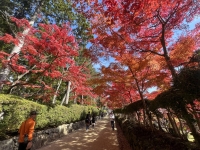
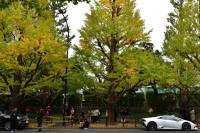



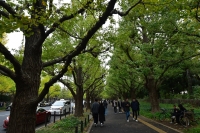
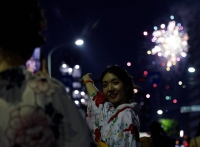
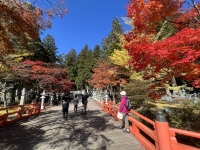
















With your current subscription plan you can comment on stories. However, before writing your first comment, please create a display name in the Profile section of your subscriber account page.